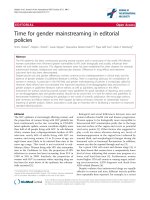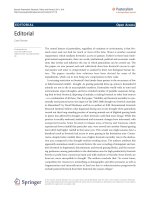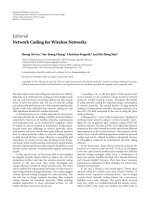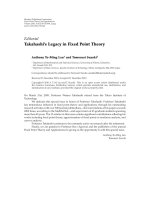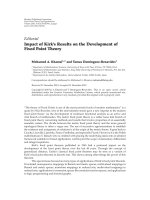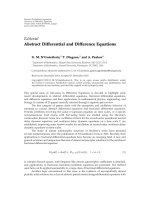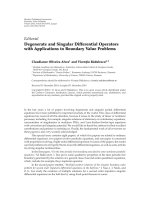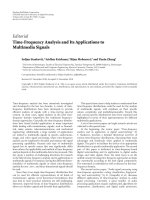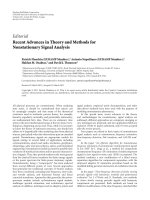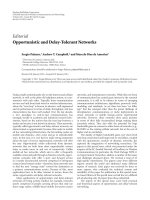báo cáo hóa học:" Editorial Enhancing Privacy Protection in Multimedia Systems" potx
Bạn đang xem bản rút gọn của tài liệu. Xem và tải ngay bản đầy đủ của tài liệu tại đây (428.31 KB, 2 trang )
Hindawi Publishing Corporation
EURASIP Journal on Information Security
Volume 2009, Article ID 710919, 2 pages
doi:10.1155/2009/710919
Editorial
Enhancing Privacy Protection in Multimedia Systems
Sen-ching Samson Cheung,
1
Deepa Kundur,
2
and Andrew Senior
3
1
Department of Electrical and Computer Engineering, University of Kentucky, 453 F. Paul Anderson Tower, Lexington,
KY 40506, USA
2
Department of Electrical and Computer Engineering, Texas A&M University, 111D Zachry Engineering Center, College Station,
TX 77843-3128, USA
3
Google Research, 76 Ninth Avenue, New york, NY 10011, USA
Correspondence should be addressed to Sen-ching Samson Cheung,
Received 31 December 2009; Accepted 31 December 2009
Copyright © 2009 Sen-ching Samson Cheung et al. T his is an open access article distributed under the Creative Commons
Attribution License, which permits unrestricted use, distribution, and reproduction in any medium, provided the original work is
properly cited.
The right to pr ivacy has long been regarded as one of
the basic universal human rights. In the last thirty years,
advances in computing technologies have brought dramatic
improvements in collecting, storing, and sharing personal
information between government agencies and the private
sector. The combination of ubiquitous sensors, wireless
connectivity, and powerful recognition algorithms makes
it easier than ever to monitor every aspect of our daily
activities. From the use of sophisticated pattern recognition
in surveillance video to the theft of biometric signals
and personal multimedia contents, people have become
increasingly wary about the privacy of their multimedia data.
To mitigate public concern about privacy violation, it is
imperative to make privacy protection a priority in current
and future multimedia systems.
Even though research on privacy enhancing technolo-
gies (PET) began more twenty years ago, most of the
existing schemes focus on textual or categorical data and
are inadequate to protect multimedia. The particular chal-
lenges include but are not limited to the difficulties in
extracting semantic information for protection, the ability to
apply cryptographic primitives to high data-rate multimedia
streams, basic signal processing algorithms for protecting
privacy without destroying the perceptual quality of the
signal, and privacy models for governing and handling
privacy rights in multimedia systems. Within the signal
processing and multimedia communities, many obfuscation
techniques have been proposed for protecting sensitive
information while allowing certain legitimate operations to
be performed. These schemes typically lack a rigorous model
of privacy, and their protection become questionable when
scaled to large datasets. The cr yptography community has
long developed rigorous privacy models and provably secure
procedures for data manipulations. These procedures are
primarily developed for fundamental computational models
like the Boolean circuits. As a result, they usually lead to a
blowup in complexity when applied to realistic multimedia
applications.
In the past few years, interdisciplinary collaborations
among experts in cryptography, multimedia, pattern recog-
nition, and data mining have produced important theoretical
results and practical protocols that began to find their
usage in practical applications. These collaborations have the
potential of not only providing enhanced level of privacy but
also revolutionizing the research frontier in the fundamental
studies of multimedia and security. The goal of this special
issue on enhancing privacy protection in multimedia systems
is to bring to the readers some of the latest developments in
this exciting area. Six papers are selected for this special issue,
covering topics ranging from encrypted-domain signal pro-
cessing, privacy data preservation to matching of scrambled
images.
The first two papers of this issue focus on the develop-
ment of sig nal processing algorithms on data encrypted with
a special type of crypto-system-Homomorphic Encryption
(HE). HE provides provably secure public-key encryption.
At the same time, HE allows many mathematical operations
to be performed on the encrypted data. Its popularity among
researchers in signal processing and data mining is not acci-
dental, though its high computational complexity still poses
2 EURASIP Journal on Information Security
a significant hurdle to overcome. In “Encrypted domain
DCT based on homomorphic cryptosystems,” Bianchi et
al. demonstrate how the 1-dimensional and 2-dimensional
Discrete Cosine Transform, among the most commonly used
signal processing operations, can be realized in the HE
domain. They propose a signal model that allows multiple
stages of noninteractive computations in the encrypted
domain, and a packing approach to group a number of pixels
together in a single encrypted word for faster computation.
Detailed bounds on accuracy and packing efficiency are also
derived.
In the second paper, “Anonymous biometric access
control”, Ye et al. use HE to realize an iris-based Anonymous
Biometric Access Control (ABAC) system. An ABAC system
uses biometrics to confirm the membership of an incomer
but is oblivious to which entry the incomer’s biometric
matches. The authors describe an interactive protocol for
iris matching in the encrypted domain. They also propose
k-Anonymous Quantization (kAQ) to reduce the search
complexity. kAQ partitions the database into groups of max-
imally diverse iris patterns before narrowing the complicated
encrypted domain search to within a single group.
Privacy-aware systems based on HE require all parties
involved in the distributed computation to agree upon a
specific computational protocol. In many practical situations
such as video surveillance and web content distribution, the
types of possible computations on the data are practically
unbounded and uncontrollable by the owner. Thus, sensitive
information within the data must first be redacted before
being released to others. An important consideration for
many applications is that the redaction process needs to be
reversible. For example, the redaction may be carried out at
an intermediate processor which does not have the owner-
ship of the data. The heterogeneity in access privileges among
receivers may also require selective revealing of redacted
objects. In addition, the reversibility of the redaction process
can fulfill the liability of faithfully preserving contents such as
surveillance videos which might be used in legal proceedings.
Threepapersinthisspecialissueconsiderdifferent aspects of
this reversibility problem.
In “Compression independent reversible encryption for
privacy in video surveillance,” Carrillo et al. propose a
permutation-based encryption scheme to be applied on
selected regions in surveillance videos such as faces of
individuals that reveal identity information. The encryption
permutes pixel values using a logarithmic signature-based
pseudorandom sequence. The proposed encryption is shown
to have robust performance—the encrypted regions can
still be decrypted after the redacted video is compressed at
different quality levels or transcoded between different com-
pression standards. Automatic methods to detect encrypted
regions are also proposed.
Instead of spatial-domain encryption, Li et al. tackle the
problem of preserving privacy data in the frequency domain
in their paper “Recoverable privacy protection for video
content distribution.” Sensitive regions are first transformed
into the Discrete Wavelet Transform (DWT) domain in
which the low-frequency contents are kept as the redacted
output. The high frequency details are treated as privacy
data and preserved as hidden data. They are hidden in
various frequency components, depending on whether JPEG
(DCT) or JPEG2000 (DWT) is used, and the selection of the
components for embedding is based on a secret key.
Both of these papers combine the specific redaction
methods with the preservation of the privacy data. Paruchuri
et al. in “Video data hiding for managing privacy information
in surveillance systems” decouple these problems and pro-
pose a high-capacity frequency-domain data hiding scheme
to preserve the privacy data regardless of the redaction meth-
ods. Their contribution is an optimization strategy to select
the appropriate frequency coefficients for data embedding
that simultaneously minimize the perceptual distortion and
maximize the compression efficiency for a target amount
of hidden data. Both reversible and irreversible data hiding
schemes are considered.
In the last paper “One-time key based phase scram-
bling for phase-only correlation between visually protected
images,” Ito and Kiya proposed a new phase-only image
matching scheme on Discrete Fourier Transform (DFT)
coefficients whose phases are scrambled for visual privacy
protection. Unlike previously proposed schemes, the match-
ing process does not require the secret key for scrambling
and theoretical justification is provided for the case when the
pseudorandom phases are restricted to two possible values.
Visual protection is measured based on error energy between
the original and phase-scrambled images, and various attack
models are also considered.
Acknowledgment
We appreciate the contributing authors for their interesting
and stimulating work. Our special thanks go to the reviewers
who helped selecting and shaping the papers presented
here. Besides choosing the highest quality papers for this
special issue, our selections of papers are also geared towards
striking a balance between inclusion of new research points
and providing different viewpoints and designs on topical
problems. We hope that this special issue can open the way
to newcomers and experts alike into innovative privacy-
enhancing designs of multimedia systems.
Sen-ching Samson Cheung
Deepa Kundur
Andrew Senior
